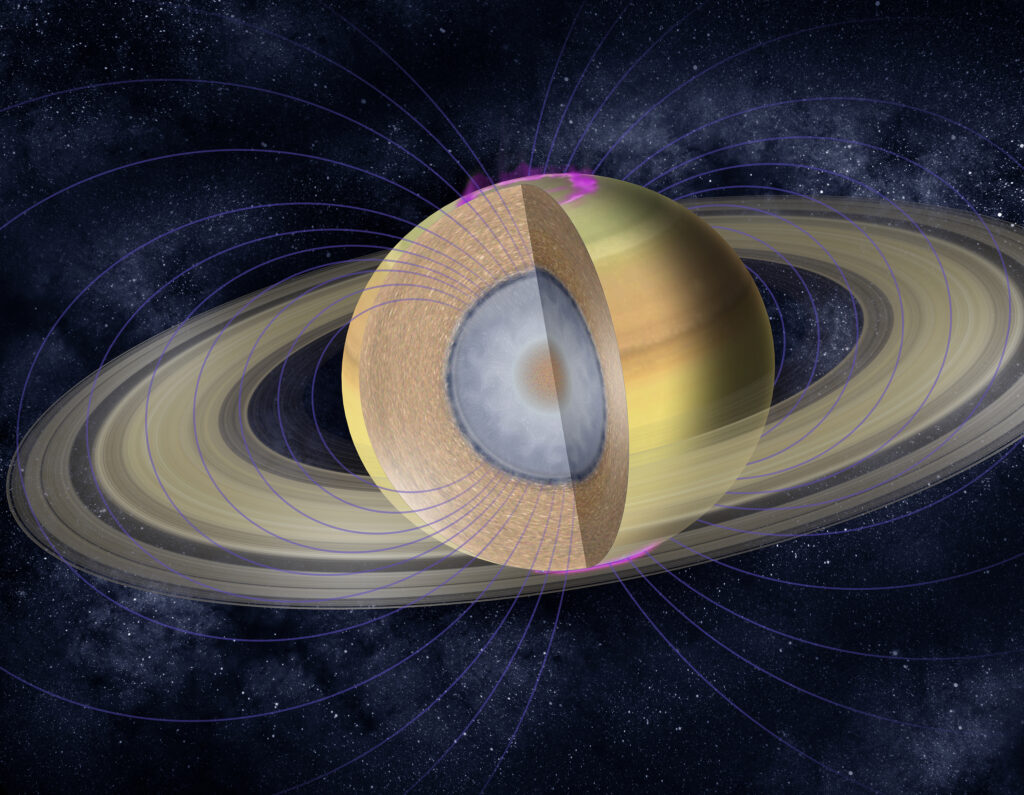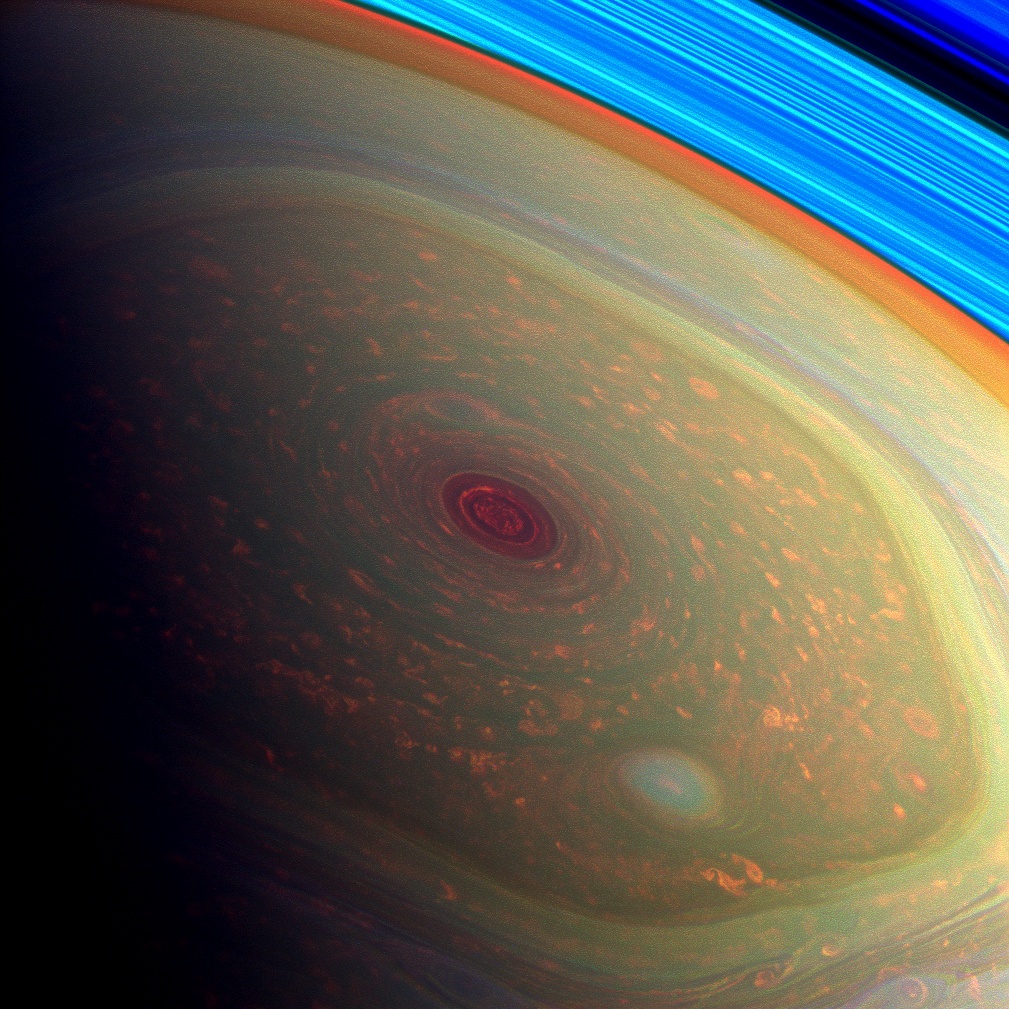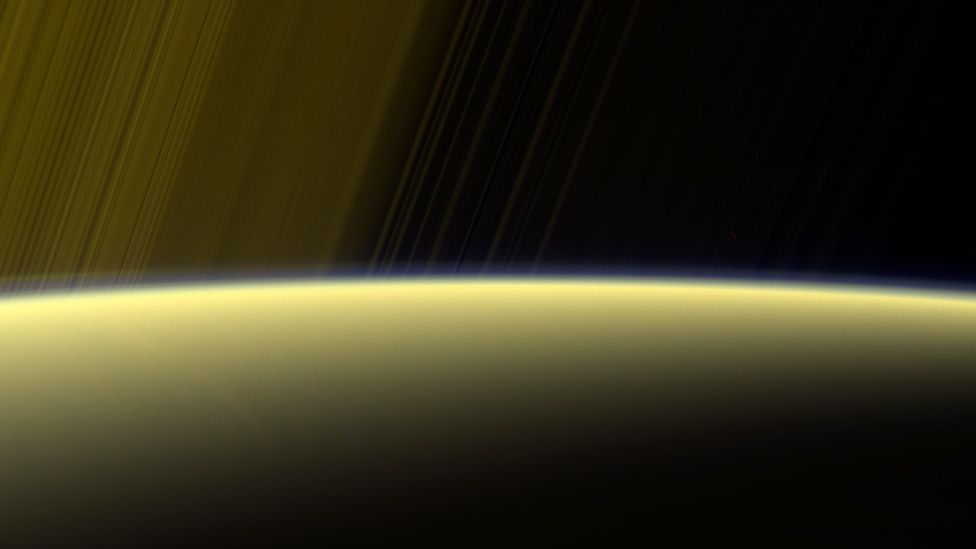The Ringed Wonder of the Solar System
© NASA/JPL-Caltech/Space Science Institute
Saturn ranks as the second largest planet in both mass and size within the solar system, and it’s the sixth closest planet to the Sun. In the night sky, Saturn presents itself as a steady, unblinking point of light, easily discernible to the naked eye. When observed through even a modest telescope, the planet, adorned with its spectacular rings, stands as arguably the most exquisite celestial object in the solar system.
While other gas giants in the solar system—Jupiter, Uranus, and Neptune—also possess rings, Saturn’s rings are exceptionally striking, which has earned it the moniker of the “Ringed Planet.” The sixth planet has an average radius of about nine and a half times that of Earth. It has only one-eighth the average density of Earth but is over 95 times more massive.
The Ringed Planet occupies almost 60 per cent of Jupiter’s volume but has only about one-third of its mass and the lowest mean density—about 70 per cent of water—of any known object in the solar system. Hypothetically, the planet would float in an ocean large enough to hold it. Both Saturn and Jupiter share a stellar resemblance in that the majority of their chemical composition is dominated by hydrogen. Additionally, much like Jupiter, Saturn’s deep interior sustains hydrogen in a state of fluid metallicity due to immense pressure.
Scientists posit that Saturn’s interior is structured with a rocky core enveloped by a profound layer of metallic hydrogen, an intermediary stratum of liquid hydrogen and liquid helium, and, lastly, an outer layer of gas. The planet boasts a pale-yellow tint attributed to ammonia crystals in its upper atmosphere. In terms of magnetic field strength, the planet’s registers at approximately one-twentieth of Jupiter’s. The outermost atmosphere generally appears subdued and lacks stark contrasts, although enduring features can emerge. Wind velocities on Saturn can reach up to 1,800 kilometers per hour (1,100 miles per hour).
The planet is distinguished by its prominent ring system, predominantly composed of ice particles, with a smaller proportion of rocky fragments and dust. As of now, there are 146 known moons orbiting Saturn, 63 of which have been officially named; this count excludes the numerous moonlets present in its rings. Titan, Saturn’s largest moon and the second largest in the Solar System, surpasses the planet Mercury in size (although it is less massive) and holds the distinction of being the sole moon in the Solar System to possess a substantial atmosphere.
ABOUT THE PLANET – SATURN
The gas giant is primarily composed of hydrogen and helium. It lacks a distinct surface, although it is presumed to possess a solid core. Its rotational motion imparts an oblate spheroid shape, causing it to flatten at the poles and bulge at the equator. Comparatively, its equatorial radius exceeds its polar radius by over 10%: measuring 60,268 km as opposed to 54,364 km.
While Jupiter, Uranus, and Neptune, the other colossal planets in the Solar System, also exhibit oblateness, it is less pronounced. The combination of this bulging effect and the rate of rotation results in an effective surface gravity along the equator of 8.96 m/s², which constitutes 74% of the gravity experienced at the poles. This value is lower than Earth’s surface gravity. However, the equatorial escape velocity, nearly 36 km/s, surpasses that of Earth significantly.
Saturn stands as the lone planet in the Solar System with a density lower than that of water—roughly 30% less. While its core is notably denser than water, the average specific density of the planet amounts to 0.69 g/cm³, attributed to its atmosphere. Jupiter possesses 318 times the mass of Earth, whereas Saturn accounts for 95 times Earth’s mass. Collectively, Jupiter and Saturn command 92% of the total planetary mass in the Solar System.
INTERNAL STRUCTURE

Saturn, often referred to as the “Ringed Planet”, has a layered composition influenced by the planet’s immense size, gravity, and elemental composition beneath its stunning array of rings.
At its core, Saturn likely hosts a relatively small and dense core composed of heavy elements like rock and metal. This core is surrounded by layers of hydrogen and helium in varying states. Above the core, there exists a layer of metallic hydrogen—a high-pressure state of hydrogen where it behaves like a metal due to the extreme conditions within Saturn’s interior. This metallic hydrogen layer generates Saturn’s magnetic field, one of the strongest and most complex in the solar system.
Beyond the metallic hydrogen layer, its interior transitions into a vast region of fluid molecular hydrogen, characterized by high temperatures and pressures. As depth increases, the molecular hydrogen undergoes a transition to a state known as “supercritical fluid,” where it becomes a dense, compressed fluid due to immense pressure.
The uppermost layer of Saturn’s interior is its gaseous envelope, composed primarily of hydrogen and helium with trace amounts of other compounds. This envelope extends outward and is the region where its well-known atmospheric features, including cloud bands and storms, manifest. The distinct cloud bands result from Saturn’s rapid rotation and its equatorial and polar jet streams.
The planet’s rapid rotation—taking just about 10.7 hours to complete a full rotation—causes its oblate spheroid shape, where the equatorial diameter is larger than the polar diameter. This oblateness contributes to the planet’s distinct bulge at its equator. Saturn’s internal composition also influences its massive and intricate ring system. While the exact origin of the rings remains a topic of study, they are thought to consist of countless icy particles ranging in size from tiny grains to large boulders. These particles are influenced by its gravity, creating the spectacular rings that encircle the planet.
SURFACE

Saturn is a gas-giant planet that lacks a solid surface like those found on terrestrial planets. Instead, its “surface” is defined by the topmost layer of its thick atmosphere. While Saturn’s lack of a traditional solid surface may be surprising, the features and phenomena visible in its atmosphere make it a captivating subject of study.
ATMOSPHERIC LAYERS
The Ringed Planet’s atmosphere is a multi-layered and intricate environment that spans a range of altitudes and compositions. Starting with the exosphere, which extends into the vacuum of space, the atmospheric layers progress inward to the thermosphere, characterized by high temperatures due to solar radiation absorption. Below lies the stratosphere, with its temperature inversion and the iconic hexagonal polar vortex. The troposphere, where most atmospheric phenomena occur, encompasses alternating cloud bands and storms. Deeper within the troposphere, water and ammonia cloud layers contribute to the planet’s distinct appearance. Moving further down, hydrogen and helium dominate, marking the transition to the planet’s denser regions.
Ultimately, the metallic hydrogen layer resides at Saturn’s core, generating its powerful magnetic field. The layers house a rich array of cloud formations, storm systems, and distinct chemical interactions, revealing the planet’s complex weather patterns and atmospheric characteristics.
CLOUD BANDS
Saturn’s cloud bands are captivating features that adorn its atmosphere with alternating light and dark stripes, creating a striking visual spectacle. These cloud bands are prominent in the planet’s troposphere, the layer where most of its atmospheric dynamics occur.
Composed primarily of ammonia ice crystals and other compounds, the cloud bands form as a result of Saturn’s rapid rotation and atmospheric circulation patterns. The alternating bands are a manifestation of Saturn’s intricate jet streams, where different atmospheric gases flow at varying speeds and directions. The differential rotation between the planet’s equator and higher latitudes contributes to the distinct banding patterns. The equatorial regions experience faster rotation, while the higher latitudes lag behind, creating the east-west wind patterns that give rise to the cloud bands.
The planet’s cloud bands are not just visually captivating; they also provide valuable insights into the planet’s atmospheric behaviour. By studying the colours, widths, and dynamics of these bands, scientists can analyze the planet’s atmospheric circulation, temperature variations, and the distribution of chemical compounds. Additionally, the cloud bands can reveal the presence of storms and vortices within the atmosphere. The most famous atmospheric feature on Saturn, the hexagonal polar vortex, resides within the cloud bands. This mesmerizing six-sided pattern, observed at the planet’s north pole, is a result of the intricate interactions between atmospheric jet streams.
HEXAGONAL JET STREAM
Saturn’s hexagonal jet stream is a remarkable and perplexing atmospheric phenomenon located at the planet’s north pole. Captured by the Cassini spacecraft, this striking feature is a hexagonal-shaped cloud pattern surrounding a central vortex. Each side of the hexagon measures approximately 13,800 kilometers (8,600 miles), making it larger than two Earth diameters. The hexagonal jet stream is an extraordinary example of the intricate atmospheric dynamics that govern Saturn’s weather patterns.
The origin of this hexagonal structure remains a subject of scientific investigation. One prevailing theory suggests that the hexagon is formed by the interactions between different layers of Saturn’s atmosphere, particularly its jet streams. These fast-moving winds, circulating in alternating directions, could create a standing wave pattern that forms a hexagonal shape. Another theory posits that the hexagon is linked to the planet’s powerful magnetic field, influencing atmospheric flows and creating a unique pattern. The hexagonal jet stream is not only visually captivating but also sheds light on the complex interactions between atmospheric forces, rotation, and possible magnetic influences. Its persistence over the years, as observed by multiple spacecraft missions, underscores the stability and significance of this atmospheric structure.
AURORAS
Saturn’s auroras are enchanting celestial displays that illuminate its polar regions with shimmering curtains of light. Similar to Earth’s auroras, these phenomena are the result of interactions between charged particles from the solar wind and the planet’s magnetic field. As these charged particles collide with gases in Saturn’s upper atmosphere, they release energy in the form of colourful light.
Saturn’s auroras are particularly intriguing due to their unique characteristics. Unlike Earth’s predominantly green auroras, Saturn’s auroras exhibit a rich spectrum of colours, including red, pink, and purple. These colours are determined by the types of gases present in the planet’s atmosphere and the specific energy levels of the incoming particles. The source of these charged particles is the solar wind—a stream of charged particles emitted by the Sun. Saturn’s powerful magnetic field guides these particles toward its polar regions, where they enter the upper atmosphere and create luminous displays. The alignment of Saturn’s magnetic field and its rotation axis plays a crucial role in the formation of auroras near its poles.
Saturn’s largest moon, Titan, also contributes to its auroras. Interaction between Titan and Saturn’s magnetosphere generates currents that further enhance the auroral displays. Studying these auroras provides valuable insights into the dynamics of Saturn’s magnetosphere and the interactions between its magnetic field and the solar wind.
CHARACTERISTICS
| MASS | 5.6834×1026 kg |
| VOLUME | 8.2713×1014 km3 |
| SURFACE AREA | 4.27×1010 km2 |
| MEAN RADIUS | 58,232 km |
| SURFACE PRESSURE | 140 kPa |
| DENSITY | 0.687 g/cm3 |
| ESCAPE VELOCITY | 35.5 km/s |
| SURFACE GRAVITY | 10.44 m/s2 |
| ABSOLUTE MAGNITUDE | -9.7 |
| NATURAL SATELLITES | 145 |
| RINGS | YES |
| MEAN TEMPERATURE | -140°C |
| SEMI-MAJOR AXIS | 1,433.53×106 km |
| ORBIT PERIOD | 378.09 days |
| PERIHELION | 1,352.55×106 km |
| APHELION | 1,514.50×106 km |
| MEAN ORBITAL VELOCITY | 9.67 km/s |
| MAXIMUM ORBITAL VELOCITY | 10.14 km/s |
| MINIMUM ORBITAL VELOCITY | 9.14 km/s |
| ORBIT INCLINATION | 2.486° |
| ORBIT ECCENTRICITY | 0.0520 |
| SIDEREAL ROTATION PERIOD | 10.656 hours |
| LENGTH OF DAY | 10.656 hours |
| MINIMUM DISTANCE FROM EARTH | 1,205.5×106 km |
| MAXIMUM DISTANCE FROM EARTH | 1,658.6×106 km |
| MAXIMUM VISUAL MAGNITUDE | -0.4 |
ORBIT AND ROTATION

Saturn follows an elliptical orbit around the Sun, similar to the orbits of other planets. However, its orbital parameters set it apart. Saturn’s average distance from the Sun, also known as its semi-major axis, is approximately 1.4 billion kilometers (869 million miles). With an average orbital speed of 9.68 km/s, its orbit takes about 29.5 Earth years to complete, meaning one Saturnian year is equivalent to almost 30 Earth years. The elongated nature of Saturn’s orbit contributes to significant variations in its distance from the Sun throughout its orbital journey.
Saturn’s axial tilt is notable, as it’s similar to Earth’s. This tilt results in the changing seasons on Saturn, similar to our planet’s changing weather patterns. Saturn experiences solstices and equinoxes, just like Earth, as its axial tilt leads to varying degrees of sunlight exposure on different parts of the planet during its journey around the Sun.
Saturn’s rapid rotation is another intriguing feature. The planet completes a full rotation on its axis in about 10.7 hours, making it one of the fastest-spinning planets in the solar system. This rapid rotation causes Saturn to be noticeably flattened at its poles and bulging at its equator, giving it an oblate spheroid shape. The unique rotation and internal dynamics of Saturn contribute to the striking appearance of its atmosphere. The alternating light and dark cloud bands and the iconic hexagonal jet stream at its north pole are driven by the rapid rotation and atmospheric circulation patterns. Saturn’s strong winds generate powerful atmospheric currents that segregate different atmospheric gases and create distinct cloud features.
Furthermore, Saturn’s rotation plays a role in shaping its magnificent ring system. The planet’s equatorial bulge affects the gravitational interactions with the particles in its rings, creating gaps and divisions within the rings. The moons near the rings, known as shepherd moons, help maintain the structure of the rings through their gravitational interactions.
ATMOSPHERE

When observed from Earth, Saturn presents a predominantly hazy, yellow-brown hue. Its atmosphere constitutes a captivating expanse of swirling clouds, intricate weather systems, and fascinating phenomena, all of which contribute to its unique appearance and behavior as a gas giant. Predominantly composed of hydrogen and helium, Saturn’s atmospheric depths extend for thousands of kilometers, distinguished by a multitude of layers and distinctive features.
One of the most striking characteristics of Saturn’s atmosphere is its alternating cloud bands. Similar to Jupiter, Saturn’s rapid rotation generates powerful jet streams and atmospheric currents, leading to the formation of alternating light and dark bands that encircle the planet parallel to its equator. These bands are composed of ammonia ice crystals and other compounds, which contribute to the distinct colours and patterns observed. Saturn’s atmospheric features also include a series of massive storms and vortices.
Perhaps the most famous of these is the Great White Spot, a storm system that occurs approximately every 30 Earth years and can persist for months. These storm systems are driven by the planet’s powerful atmospheric dynamics and are crucial for understanding the complex interactions between gases, heat, and energy within Saturn’s atmosphere.
One of the most enigmatic features of Saturn’s atmosphere is the hexagonal jet stream at its north pole. This hexagon, observed by the Cassini spacecraft, is a stable and intricate cloud pattern with each side measuring about 13,800 kilometers (8,600 miles). The origin of this hexagonal shape is still a subject of scientific investigation, with theories ranging from atmospheric wave interactions to interactions with the planet’s magnetic field.
Saturn’s upper atmosphere is adorned with a series of hazes and clouds. These cloud decks consist of hydrocarbon compounds, contributing to the muted colours observed in the planet’s atmosphere. The presence of these compounds gives Saturn its distinct pale gold hue when viewed from space.
MAGNETIC FIELD

Saturn’s magnetic field is a dynamic and powerful phenomenon that extends far beyond the planet itself, shaping its environment and interactions with space. Similar to Earth, Saturn has a global magnetic field that is generated by the movement of electrically conducting material within its interior, a process known as the dynamo mechanism. However, Saturn’s magnetic field is unique in several ways. It is approximately 578 times stronger than Earth’s magnetic field, giving it the title of the second-strongest magnetic field in the solar system, surpassed only by Jupiter. This powerful magnetic field has significant effects on Saturn’s surroundings, including its rings, moons, and interactions with the solar wind.
The planet’s magnetic field is tilted relative to its rotation axis, causing its magnetic north and south poles to be distinct from its rotational poles. This tilt has implications for the planet’s magnetic interactions and the behaviour of its magnetosphere. One of the most fascinating features of Saturn’s magnetic field is its complex and asymmetrical nature. Unlike the relatively symmetric magnetic field of Earth, Saturn’s magnetic field is influenced by its rapid rotation and internal composition. This complexity leads to variations in the field’s strength and orientation across different latitudes.
Saturn’s magnetosphere, the region around the planet influenced by its magnetic field, is vast and dynamic. It extends far beyond the planet and interacts with the solar wind—a stream of charged particles emitted by the Sun. This interaction forms a protective bubble around Saturn, deflecting and trapping some of the solar wind particles. These trapped particles create radiation belts within Saturn’s magnetosphere. The interaction between Saturn’s magnetic field and its moons is also significant. Some of its moons, known as “magnetospheric moons,” orbit within or interact with the planet’s magnetosphere. These moons generate unique interactions, including induced magnetic fields and plasma interactions.
GRAVITY

The gravitational pull on Saturn is significantly different from what we experience on Earth. The gas giant, predominantly composed of hydrogen and helium, lacks a solid surface like terrestrial planets.
As a result, its gravitational field is intricate. At its equator, where the planet bulges due to its rapid rotation, the gravitational pull is slightly weaker compared to the poles. The overall strength of Saturn’s gravitational field is approximately 10.44 m/s², which is about 1.06 times that of Earth. This means that if you were on Saturn’s surface, you would weigh roughly 6% more than you would on Earth. This relatively weaker gravity, combined with the planet’s lack of a solid surface, makes landing missions challenging and has implications for the complex interactions within its ring system and the orbits of its numerous moons.
Previous Planet – “Jupiter“
Next Planet – “Uranus“
